About Us
The Early Years 1880-1890
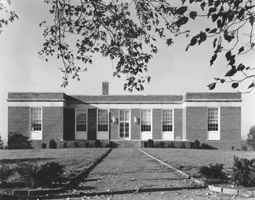
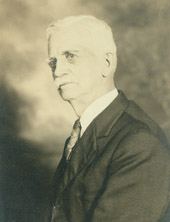
H.W. & O.S. Kriebel and the Carnegie Library
Howard Kriebel in 1907 resigned as curator of the collection and his cousin, the Reverend Oscar Schultz Kriebel, Headmaster of Perkiomen School, became the collection’s new custodian. At the beginning of Rev. Kriebel’s custodianship, the collection was being stored in the school’s gymnasium, and Reverend Kriebel’s main challenge was to find a permanent building in which to store the collection.
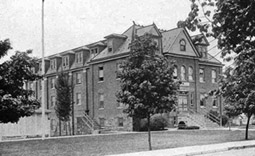 | 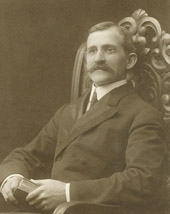 | 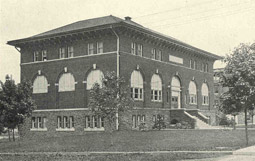 |
In 1906 he had secured a matching grant from Andrew Carnegie for $20,000 for a new library building. In the negotiations between Andrew Carnegie and donors, it was agreed that " one purpose of the library building was to provide floor space and a fireproof section or vault for the housing, use and management of the collection of historical materials being formed by the Schwenkfelder Church." By 1910, however, Rev. Kriebel needed to raise over $60,000 as the school’s rising debt reached $38,000. With contributions coming from school trustees, alumni and church members, the money was raised and the new library building was dedicated on November 20, 1913.
The Years Abroad


The Corpus Project
A year prior to the 1885 General Conference decree, in a circular letter and at the sesquicentennial Schwenkfelder Memorial Day service, Dr. Chester David Hartranft, a professor of ecclesiastical history at Hartford Theological Seminary, made an impassioned appeal to the Schwenkfelder community for a need to publish a comprehensive, scholarly “encyclopedic critical edition” of the works of Caspar Schwenckfeld in order to secure his “rightful but long-denied place in Reformation scholarship.” The appeal was accepted most positively and the fall 1884 General Conference appointed a committee to consider Hartranft’s call to produce a sixteen volume corpus of the works of Caspar Schwenckfeld von Ossig.
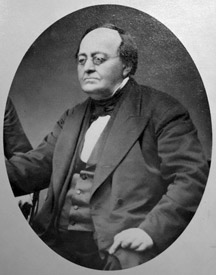 | 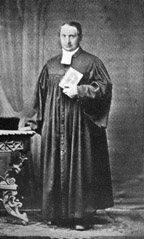 |
Dr. Hartranft’s Corpus Schwenckfeldianorum project itself was influenced and inspired by the preceding work of men like Friedrich Schneider and Oswald Kadelbach. These men, in the early-to-mid 19th century had each contributed to the modern era of Schwenckfelder scholarship and Schwenkfelder history. Friedrich Schneider, after reading the work of Reformation historian Gottfried Arnold became deeply interested in Schwenkfelder history and, in his study, accumulated an unrivaled knowledge and manuscript collection of Schwenkfelder history up to that time. Kadelbach’s 1860 Ausführlich Geschichte Kaspar v. Schwenkfelds und der Schwenkfelder in Schlesien was an additional step in the path towards recognition of the need for a comprehensive and scholarly edition of Schwenckfeld’s work.
Dr. Hartranft set sail for Germany in May 1885 where he began a preliminary search of libraries and archives for Schwenckfeld’s writings, and soon produced a bibliography of over 900 documents. As his research continued over the next few years more and more documents were uncovered. Yet, during the 1880s and 1890s the Corpus project, despite its intensive research, massive accumulation of copied documents and enthusiastic financial backing, failed to see a single volume published. Chester Hartranft’s other duties at Hartford, his health problems, plus his insistence on thorough scholarship in the German tradition, caused delay after delay in publication.
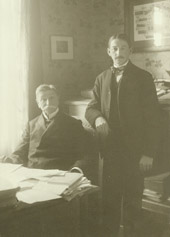 | 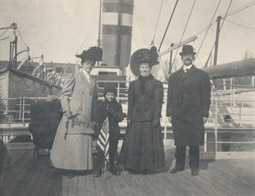
|
However, by 1903 Dr. Hartranft had retired from Hartford so that he could focus all of his time on the Corpus. He moved with his family to Wolfenbüttel, Germany whose holdings contained the largest collection of Schwenkfeldian documents in all of Europe. The documents collected by Howard Kriebel traveled with Dr. Hartranft to Germany as well. Still the project was bogged down by Hartranft’s administrative duties and his insistence on thorough scholarship. In 1904 Elmer E.S. Johnson was appointed assistant editor and sent to Germany to speed up work on volume I which still did not appear for another three years. After that time, and with the addition of Selina Gerhard Schultz, first as secretary, then as editor the project’s work proceeded much more smoothly but still slowly.
Finding a Permanent Home
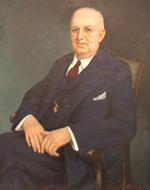

The new building was dedicated on October 27, 1951. Earlier that year title to the collections, endowment funds and rights of occupancy to designated areas of the Carnegie Library were formally transferred from the Board of Publication to the Schwenkfelder Library. The contents of the vault had been moved in September and the rest of the library collection was moved as time permitted. The museum collection remained in the Carnegie building and was given over to exhibit space for the artifacts. Over the years this collection grew and more thought had to be given to consider suitable space for its storage, display and protection.
Through the generosity of Wayne C. Meschter, the efforts of the Schwenkfelder Board of Directors and Director Berky the library made a concerted effort in the late 1950s to increase the library’s endowment fund in order to insure funding for the basic operating costs. After acquiring the full share of stock in Mr. Meschter’s preserve company, Wayne American Co., the library then dissolved the corporation and sold the company’s Philadelphia building. This insured the library with sufficient monthly cash flow and endowment funds.
Directors
Andrew Berky saw the need to make the collection more accessible to the public, as well as continue in the tradition of Dr. Hartranft, Selina Schultz and Elmer Johnson’s Reformation scholarship. Berky wrote numerous books (see bibliography on website for listing) and lectured on Schwenkfelder and local history. At this time the library was still working on the publication of the Corpus and supplemented this work by supporting the research of Reformation scholars Joachim Seyppel and John Joseph Stoudt. Seyppel’s Schwenckfeld, Knight of Faith and Stoudt’s translation of Schwenckfeld’s Passional and Prayerbook were published in 1961 to mark the 400th anniversary of Schwenckfeld’s death.
With the completion of the Corpus in 1961 and the library’s endowment secure Berky began to see the need for a re-evaluation of Schwenkfelder history. He saw the traditional, insular world of the Schwenkfelders as shrinking and losing significance. He thought now there was a need to change the library’s mission with the changing times or else it would lose its vitality. There was also a need, in his mind, to develop a relationship with a Reformation scholar who could “properly assess its [the collection’s] intrinsic worth in relationship to Protestant development throughout the past four centuries, and relate its significance in terms of modern theological thought.”
It was not until 1973 that the library found a scholar who was willing to take on the duties, though temporary, of being a consultant for the library. Peter C. Erb, who had originally come to Pennsburg in 1970 from the University of Toronto as part of his PhD research into the role of late Medieval spirituality in the work of Gottfried Arnold agreed to a fifteen month consultantship where he would “oversee communication with interested scholars in the field [of Reformation Studies] and supervise a modest program of acquisition of new volumes…to augment the library collections.”
Dr. Erb left the Schwenkfelder Library after his fifteen months of consulting to return to his tenured position at Wilfrid Laurier University in Waterloo, Canada. Yet, since that time, the library has enjoyed a very close personal and professional relationship with Dr. Erb. Though staying here only a short while as a consultant Peter has since been the library’s Associate Director and has published books and articles on Schwenckfeld and the Schwenkfelders (see bibliography). In addition he organized the 1984 colloquium which was organized to celebrate the 250th anniversary of the arrival of the Schwenkfelders in America, and brought scholars from throughout the U.S., Canada and Europe to Pennsburg to present papers on various aspects of Schwenkfelder and Reformation history.
At the same time badly-needed cataloging tasks were being undertaken by Upper Perkiomen native Fred Grater who started as a part-time employee in 1965 and stayed on for ten years. Fred Grater received a master’s degree in religion and culture from Wilfrid Laurier University in Waterloo, Canada and wrote his thesis on Schwenckfeld’s Commentary on the Augsburg Confession. Another invaluable asset to the library came from the local community. Dennis Moyer started at the library as a volunteer with the museum collection in 1977. He provided expert knowledge of local history and a great understanding of the meaning and interpretation of our artifacts and fraktur. Dennis became the Director in 1983 and his directorship culminated with the publication his book Fraktur Writings and Folk Art Drawings of the Schwenkfelder Library Collection published in 1988.
2001-Present
In the 1990s a fire badly damaged Kriebel Hall, the main building of the Perkiomen School. This prompted the Board to consider, relocating the museum collection to a more secure, fireproof building. A capital campaign was started to raise money for an addition to the library for storage and exhibition of the museum collection.

|
Ground was broken in March of 2000 and the building was completed and rededicated in June 2001. During the period of the construction the building was closed but the staff continued to work in the midst of the construction. The museum collection was inventoried and boxed for moving and the library collection was boxed and stored off site. Since 2001 the, rechristened, “Schwenkfelder Library & Heritage Center” has opened its doors to researchers, students and families interested in the Schwenkfelder story or, more generally, Pennsylvania German culture and life.
As the building of the 2000 addition was underway, the idea of adding a barn to the site was raised and soon became a driving factor. The Board of Directors was equally divided over erecting a barn, and the issue was suspended. Even before the new 2001 addition to the building was completed, comments about the need for more storage also were raised. Conversations continued about adding more exhibit galleries and museum, archive, library, and general storage space, and the barn issue was raised again. The decision was made around 2015 to add a barn. The Board of Directors approved a plan to erect a barn and add substantial storage in 2016. On November 11, 2018, ground was broken for the expansion and modifications to the existing building. The corner stone was laid in 2019 and the building was finished in July 2020.
The construction had a setback within the first month when a plumbing accident flooded the Ground Floor with some 18 inches of water. None of the museum objects was severely damaged, but the floor had to be replaced as well as the reception desk. Exhibit platforms and displays required renovation. A second, minor, related flooding occurred a short time later.
The barn on the Fred Seipt farm was dismantled and transported to the SLHC site where it was rebuilt in early spring 2020. On the First Floor level, the terrace in front of the entrance to the original library building was converted into a new Board Room. The old Library Director’s office has become the “Mezzanine Room,” or genealogy and archive workroom. Room. The former Silesian Room is now the Weber Conference Room. A two-story archival storage area was added. The Stauffer Education Room and the Putera Meeting Room were remodeled. The Rural Entrepreneurship Gallery and Rural Life Galleries were added, and the Gift Shop was enlarged. Due to the COVID-19 pandemic of 2020, these spaces did not open to the public until later in the year. Descendants of the original Schwenkfelder immigrants have donated a very high percentage of the historical items in the library / museum.

